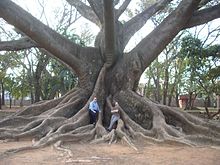Buttress root



Buttress roots (stilt roots or prop roots) are large roots on all sides of a shallowly rooted tree. Typically, they are found in nutrient-poor rainforest soils and do not penetrate to deeper layers. Almost all types of mangroves have these types of roots. They prevent the tree from falling over (hence the name buttress) while also gathering more nutrients. Buttresses are tension elements, being larger on the side away from the stress of asymmetrical canopies.[1] The roots may interwind with buttress roots from other trees and create an intricate mesh, which may help support trees surrounding it. They can grow up to 30 feet (9.1 m) tall and spread for 30 metres above the soil then for another 30 metres below. When the roots spread horizontally, they are able to cover a wider area for collecting nutrients. They stay near the upper soil layer because all the main nutrients are found there.[2]


Notable and historic specimen trees with buttress roots
- Ceiba pentandra of Vieques, Puerto Rico
- Ficus macrophylla in Santa Barbara, California, USA
References
- ^ Young, T. P. and V. Perkocha. "Treefalls, crown asymmetry, and buttresses". Journal of Ecology 82:319-324.
- ^ Crook, M. J.; Ennos, A. R.; Banks, J. R. (1997). "The function of buttress roots: a comparative study of the anchorage systems of buttressed (Aglaia and Nephelium ramboutan species) and non-buttressed (Mallotus wrayi) tropical trees". Journal of Experimental Botany. 48 (9): 1703‑, 1716. doi:10.1093/jxb/48.9.1703.
{{cite journal}}: CS1 maint: multiple names: authors list (link)
